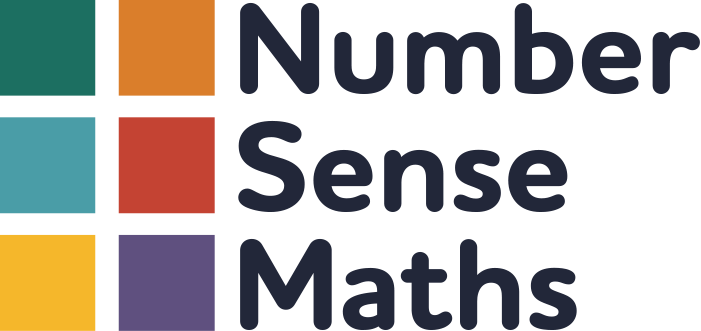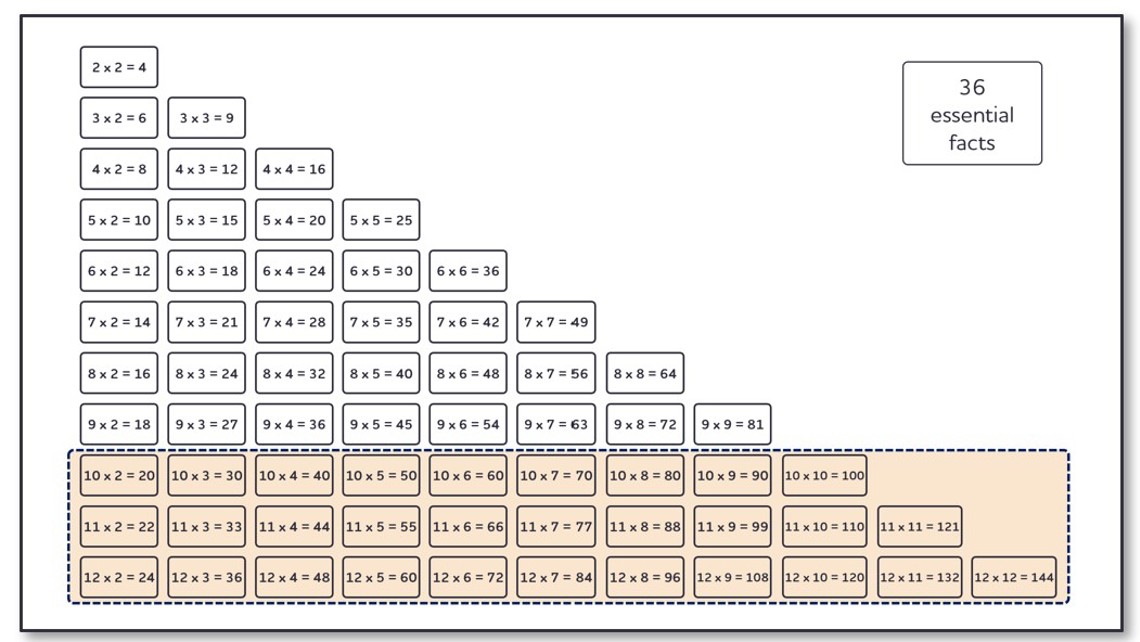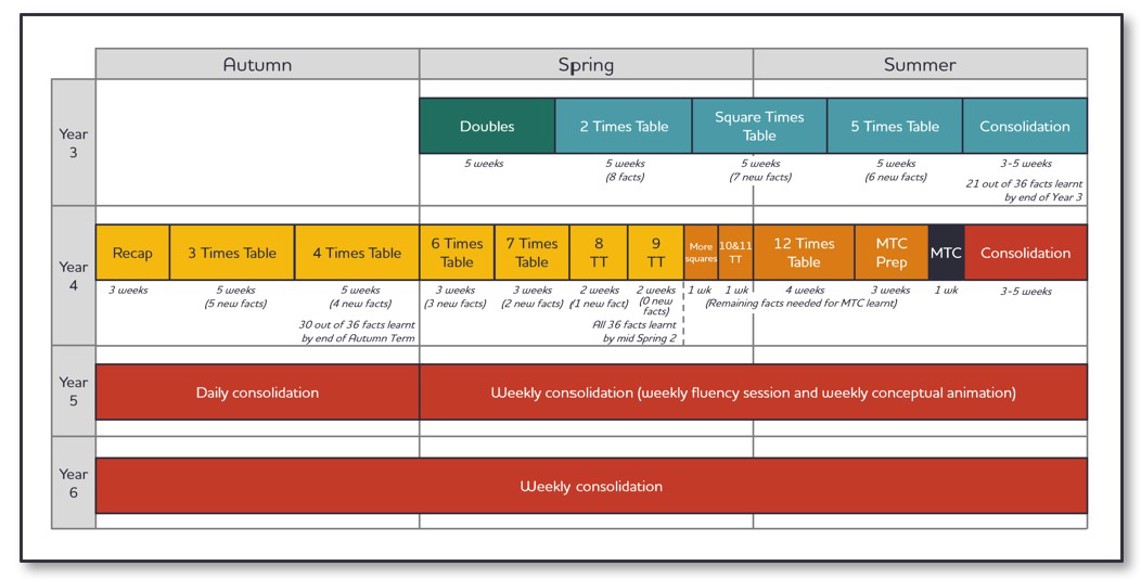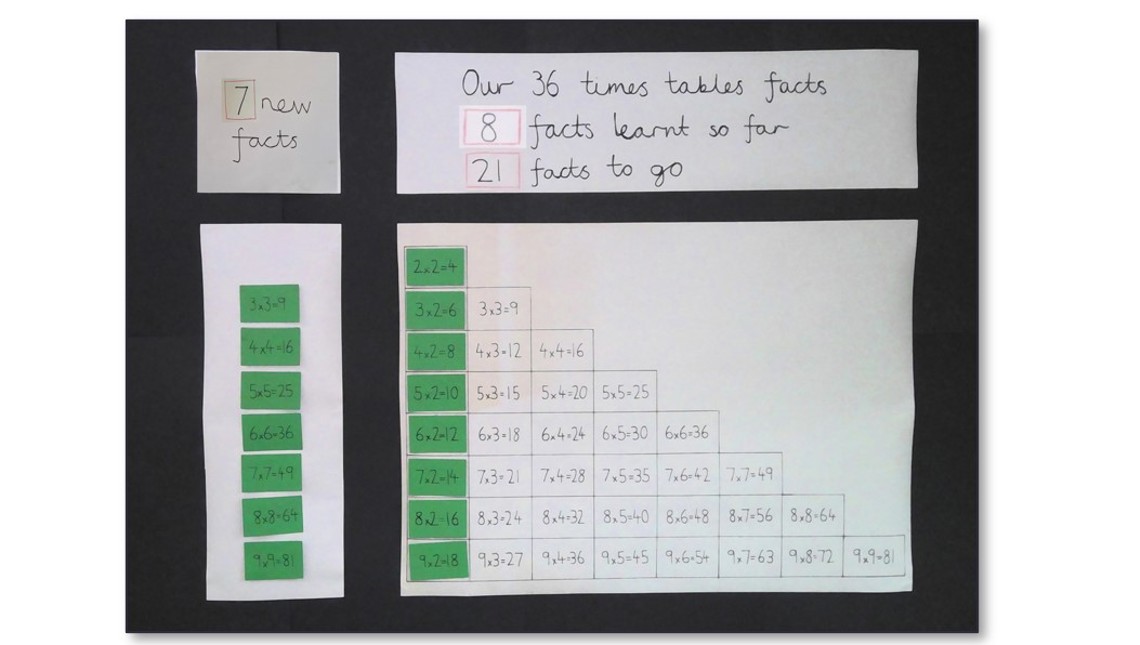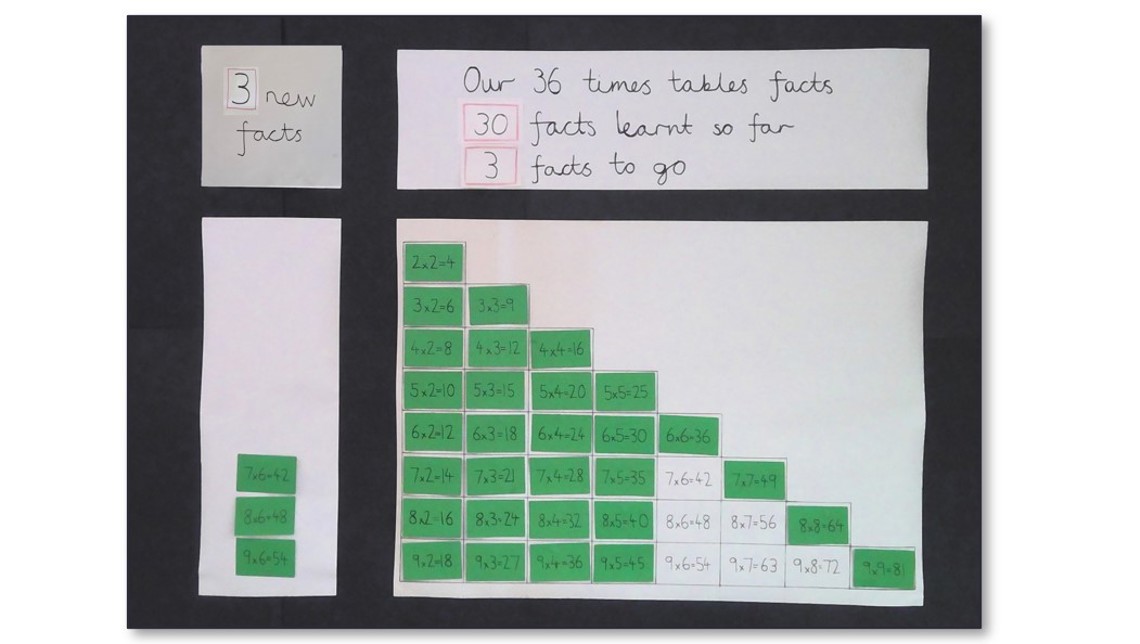Developing a times tables curriculum and pedagogy
The idea of defining a curriculum for factual fluency is increasingly taking hold in primary schools. Here we explain some aspects which we think are important to consider as you define your approach to teaching times tables facts to fluency. These are all built into our Times Tables Fluency programme, but will provide a useful checklist whatever approach you use.
Define the set of facts you teach
To teach something well we need to know what we are teaching, so first be clear about exactly which facts children need to learn. Just as in history we need to go beyond saying the children learn 'about Ancient Greece' and agree exactly what it is they are learning about Ancient Greece, it means going beyond saying the National Curriculum requirement of “times tables up to the 12 times table”. Sit down with the grid of 144 facts (1x1 to 12 x 12) as a teaching team, and identify exactly which you teach and how you group them. If you have taught 7 x 4 = 28, then what, precisely, is your school’s approach to teaching 4 x 7 = 28 for example? Define and agree this at a whole school level, so everyone gives the same answer to this question. Often our experience is it is left to individual teachers to work out this level of pedagogy – the “Well what I do is…” approach.
The curriculum we have defined in the programme we have written prioritises teaching the facts which are focused on in Shanghai: the 36 facts up to 9 x 9. This video explains why. We also cover the 11 and 12 times table well enough for children to know them for the multiplication tables check (MTC) in England. If you are not in England you can leave them out. If you are in England, then once you are through the MTC you can decide whether to focus on facts to 9 x 9 (our recommendation) or continue with facts to 12 x 12. The structure of the final stage of our programme allows you to choose between these two options.
Define when every fact is taught
Your phonics scheme sets out precisely which GPCs you teach when. Times tables facts are the ‘small unit’ equivalence of GPCs for multiplicative calculation, so we suggest you plan the teaching of these facts in the same way. When, for example, do children in your school come to know that 7 x 4 = 28? In our Times Table fluency programme it is Year 4, Autumn 2, Week 3. Working this way means everyone learning the same fact at the same time, just as for phonics. This means we as teachers can discuss what we do and don’t yet know with children. “We haven’t learnt 9 x 6 yet. Look at the display for that one.” Or “We have already learnt 8 x 3. Say it to me, “Eight threes are…””
The plan above shows how our Times Tables Fluency programme builds up the facts across Years 3 and 4. Until Christmas of Year 3, the factual fluency focus is on securing addition and subtraction facts. We strongly advise completing teaching addition and subtraction facts to fluency before starting on times tables facts, otherwise you will have some children who are still finger counting for addition and subtraction facts. If you use a structured approach to teaching times tables, a January start in Year 3 is plenty of time for children to get fluent before the MTC.
Be explicit with the children about where you are on the journey
This has been something we have learnt in feedback from schools using our Number Facts Fluency programme, but on reflection shouldn’t really have surprised us. Just as we as teachers found it incredibly useful mapping facts out that we need to teach (yes – it turns out that knowing what it is you are trying to teach is very helpful!) we have also found being explicit about the facts we are learning and where we are in the process of learning them is incredibly supportive to children. We’ve found it’s possible to avoid times tables becoming the insurmountable challenge which they have sometimes felt like to me - and many children I have taught - in the past. Give the children the message “We’re going to learn our times tables. I’ve got a great method we will use. We only have these 36 facts to learn. We’ll learn them a few at a time over a year and a half, and it’s my job to make sure it works for you all.” Then be really explicit as you go about how many facts you have learnt already.
In the Times Tables Fluency programme this discussion is scaffolded by a display. You need to have this up through the programme (in both Year 3 and 4), and you move facts over as you learn them. The images on the right show what the display looks like at two different points within the programme. As an example, the second image shows that by the time the children start the 6 times table, they have already learnt 30 facts in previous times tables you have taught. They learn 3 new facts in the 6 times table, and after that there are only 3 more to learn. The display also has a secondary purpose which is to provide a way where all the facts you teach are always displayed, so children can find facts you haven’t yet taught if they need them. If you have mapped our your times tables curriculum in the way we recommend in point 2 then a display like this is easy to incorporate in your practice.
Be explicit with the children about how they will come to remember the facts
Just as we suggest being explicit about the facts being learnt, we also suggest you are explicit with the children about the process of learning them. First of all be clear about this as a staff. Whatever your approach to teaching times tables, make sure that as a staff you all understand exactly what it is about the approach which causes the facts to move into long term memory.
The Times Tables Fluency programme teaches both recall and conceptual understanding, but for the recall element we found the diagram from the EEF report “Cognitive Science in the classroom” useful. We set out to design an approach which would enable repeated oral rehearsal and repeated retrieval of facts as the route to recall. We centre a daily fluency session around a carefully constructed series of booklets (bringing in new facts according to the timetable already outlined) which the children fill in for two minutes a day. During the session they recall already-known facts, and copy not-yet-known facts from the display. During the second part of the session, the teacher says each fact to the children in a rhythmic lilt (like a song lyric) and they repeat them back. These two elements (the retrieval and oral rehearsal) are the mechanism for learning, and we explain this to the children so they understand how they are learning the facts. Some children get to a stage where they can ‘imagine’ this sound in their heads. Others choose to verbalise out loud when they are recalling a fact.
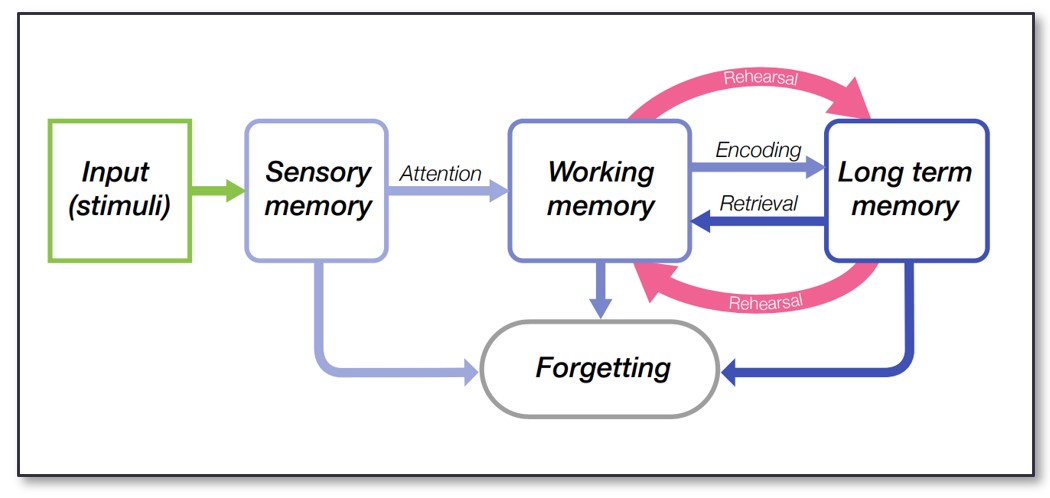
From the EEF report 'Cogitive science approaches in the classroom'
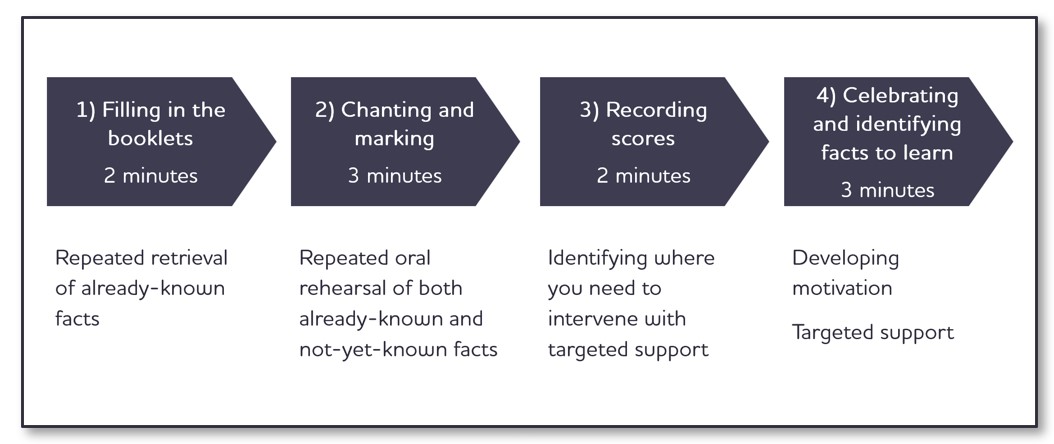
Structure of the 10 minute daily fluency session
Connect multiplication with division
I have strong memories from when I was teaching Year 3 of children saying they didn’t “get” division. Whatever method you take to learning times tables, we strongly suggest you make the most of the opportunity to repeatedly connect to the commutative multiplication fact and the inverse divisions. Or, if you take a factor led approach, be clear on how exactly children learn to link these back to calculations expressed as multiplication and division. Again, my advice here would be to go beyond saying "Well once they know that, then they can apply it to related facts" and be really specific about where the children are getting that practice, and how specifically those links are explained and taught within your school.
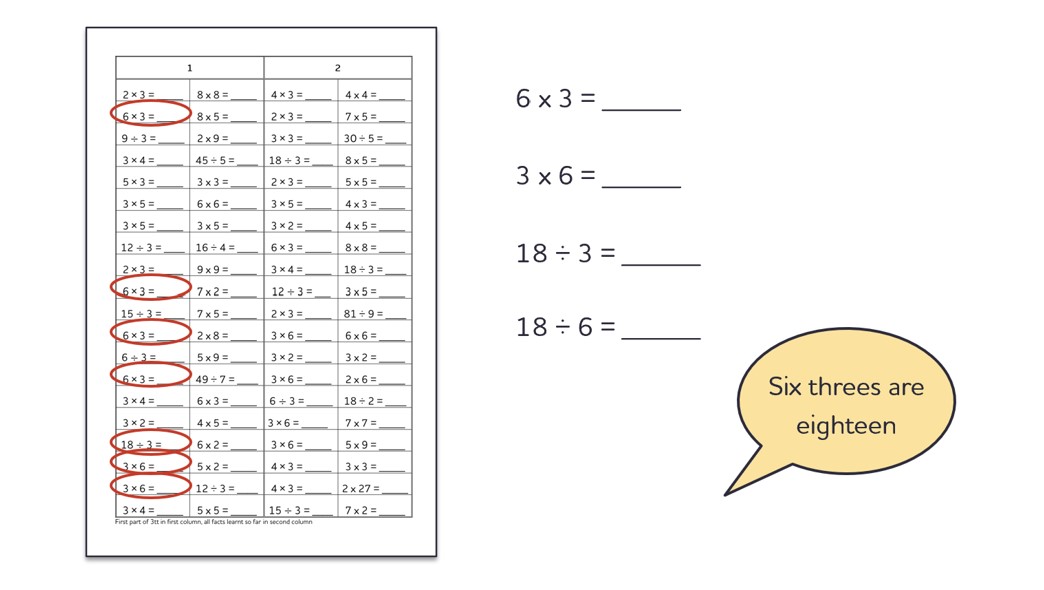
In our approach it is a case of making connections between the fact learnt as a verbal sound pattern (“Six threes are eighteen” for example) and the other facts in the family. The conceptual lessons within the programme and the booklet design explicitly build in these connections. In the first units (2 times table) we introduce commicative multiplications, and then the link between division and multiplication, over a three week period. After the first unit all the facts are introduced from the start. However during the flueny session all are ‘read’ in the same way: as a multiplication with the larger factor first. Manipulating multiplication and division equations from within and beyond the times tables becomes second nature to children because they are practising this skill every day. The benefits extend well beyond the sessions themselves and into any multiplicative thinking in the main maths lessons.
Develop a belief among staff and children that all are capable of learning their times tables
The penny drop moment for us at the school where I work on this front was reframing around there being 36 facts to learn, rather than 12 times tables with 12 facts in each. Before then I think we felt the task was insurmountable for some, and in fact various Ed Psych reports for children I had taught had said as much: they won’t be able to learn their times tables so will need a times tables grid to hand in lessons. But realising that there were 36 facts to teach over 50 weeks, each learnt like a song lyric: well, we all fundamentally believe that all of our children were capable of that. So I’d suggest that as a team you get that on the table from the start. Literally sit down and name any individual children who you think can’t do this. There may be some, but it is a tiny minority, and in most classes the number of children who can’t learn their times tables will be zero. If you follow the principles here you will find that some children with cognition and learning SEND needs do exceptionally well with this approach, outperforming children who may be much higher attaining in the main maths lesson. I’ve seen it several times, and once you have then it helps reinforce the feeling that it is achievable – I would say for all children accessing a mainstream education in any significant way. Not working them out, counting on fingers or anything else, but just knowing, straight away, every fact.
In our approach we talk about ‘engineering success’. Because the robust systems and resources mean the vast majority of children make good progress with the universal approach, it becomes manageable to make little tweaks for the small minority of children who may need access strategies or targeted support.
Track progress and intervene quickly
Whatever approach you use, how you will know whether your children are making good progress? And what specifically will you do if they are not? It is our job as teachers to find ways for all children to become fluent in these facts. One of the main benefits of having an approach in which everyone learns the same times tables at the same time is that it is much easier to assess how children are getting on, identify very quickly where there might be gaps opening up, and intervene straight away. The top image represents the range of times tables knowledge you might have in a typical class where times tables are not taught systematically. Some children will pick them up. Others will still be on 2s, 5s and 10s in Year 6. With such a range of attainment and knowledge any meaningful individualised support just isn't possble. However, raising the quaility of universal provision (structured approach, systematic teaching) means the majority will learn alongside peers, and just a small number need anything more than this. Suddenly this becomes manageable.
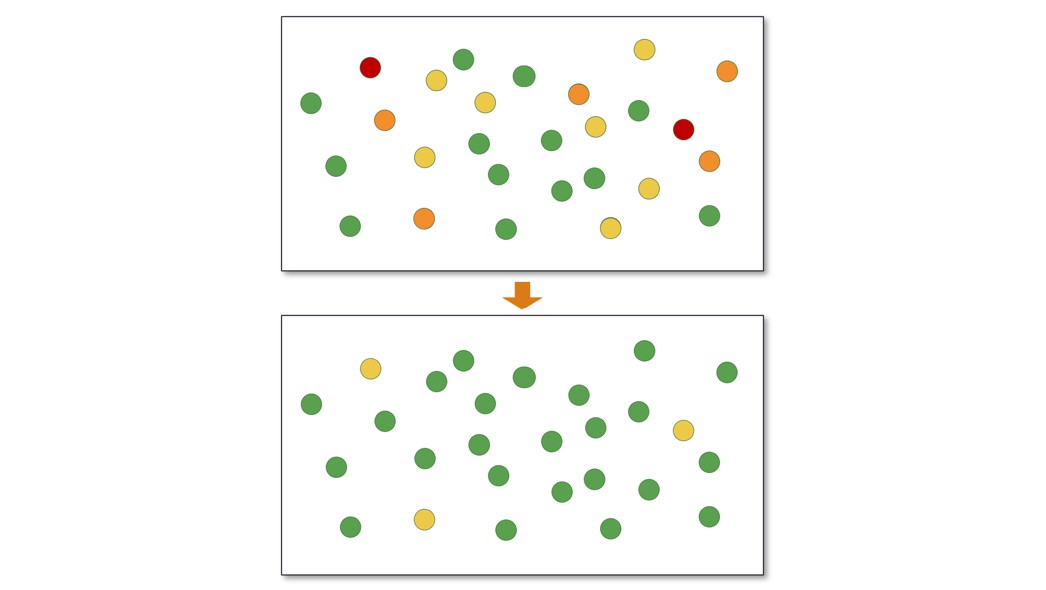
In our Times Tables Fluency programme we provide really detailed guidance on the kind of specific targeted support strategies you may use, the majority of which take place within your 10 minute daily fluency session, rather than as something extra to timetable in. This is where you bring your knowledge of and relationships with the children to the fore, problem solving to work out and remove particular barriers for particular children. Because it is only a small minority it feels interesting and rewarding work rather than unmanageable and overwhelming.
A useful framework for thinking about all of this is making sure that the learning of times tables is not outsourced to children and parents - we are the experts and making sure you can describe your approach as 'teacher led' will, in our experience, give you the best chance of getting really robust systems set up in school which make sure all children leave primary school fluent in their times tables and inverse division facts.
To read more about our Times Tables Fluency programme click here.
To sign up for a free introductory training session click here.
